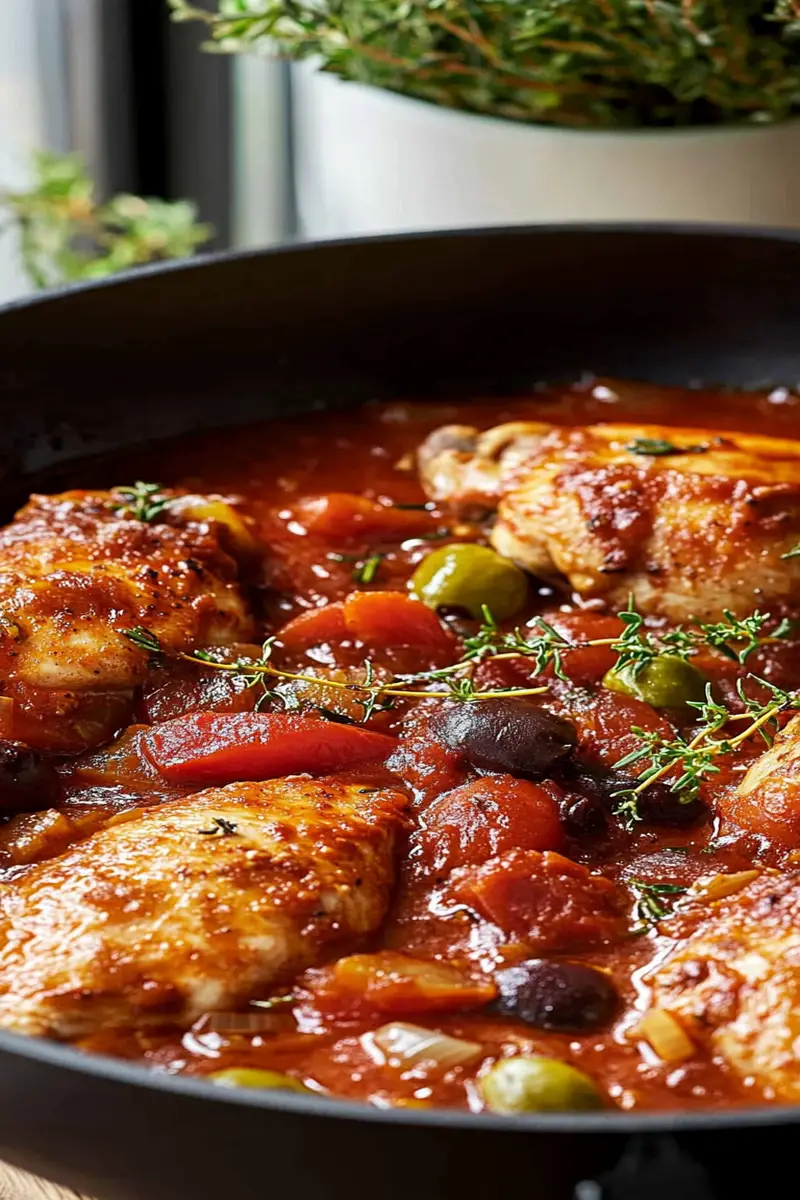Introduction and Quick Summary
Chicken cacciatore is a classic Italian dish that brings warmth and flavor to your dining table. This hearty recipe features tender chicken simmered in a rich tomato sauce, infused with aromatic herbs and spices. Originating from the rustic kitchens of Italy, this dish has become a beloved favorite worldwide. Packed with vibrant bell peppers, mushrooms, and onions, chicken cacciatore is not just a meal; it’s an experience that invites you to savor every bite.
In this article, we will guide you through the process of creating the perfect chicken cacciatore from scratch. Whether you’re preparing a cozy family dinner or hosting friends for a gathering, this recipe promises satisfaction for everyone. You’ll learn about the essential ingredients, step-by-step preparation instructions, and tips for serving and storing leftovers. By the end of this post, you will be ready to impress your dinner guests with your culinary skills while filling their plates with deliciousness.
So grab your apron and let’s embark on this flavorful journey together! With simple techniques and accessible ingredients, making chicken cacciatore at home is easier than you think.
Main Ingredients
Chicken
The star of our chicken cacciatore is undoubtedly the chicken itself. For this recipe, you will need around 4 pounds of bone-in chicken pieces (like thighs and drumsticks) or 2 pounds of boneless skinless chicken breasts. Bone-in pieces offer more flavor as they cook slowly in the sauce. Ensure your chicken is fresh or properly thawed if frozen to achieve the best texture and taste.
Olive Oil
You will need approximately 2 tablespoons of extra virgin olive oil for sautéing the vegetables and browning the chicken. Olive oil adds richness to the dish while enhancing flavors. Choose high-quality oil for optimal results as it significantly influences the final taste of the sauce.
Bell Peppers
Two medium-sized bell peppers—preferably one red and one yellow—bring color and sweetness to your dish. Slice them into strips so they can easily meld into the sauce during cooking. Bell peppers not only add texture but also provide important vitamins that contribute to a balanced meal.
Onions
For depth of flavor, use one large onion—preferably yellow or white—chopped finely. Onions are essential for building the base flavor in any savory dish. Sautéing onions until they are translucent releases their natural sweetness, which enhances the overall taste of your cacciatore.
Garlic
Garlic is crucial for its robust aroma and flavor; you’ll need about 4 cloves minced or sliced thinly. Fresh garlic adds depth to any dish but be cautious not to burn it when sautéing as it can turn bitter quickly.
Mushrooms
Add 8 ounces of sliced mushrooms (button or cremini) for an earthy flavor that complements the other ingredients beautifully. Mushrooms absorb flavors well during cooking and contribute a meaty texture without being overwhelming.
Tomatoes
Use one 14-ounce can of diced tomatoes along with 1 cup of tomato sauce or crushed tomatoes as the base for your sauce. Tomatoes provide acidity that balances out the richness of other ingredients while forming a delicious sauce that envelops each piece of chicken.
Herbs & Spices
Seasonings play an important role in highlighting flavors; use 2 teaspoons each of dried oregano and dried basil along with salt and pepper to taste. Fresh herbs can also be added at the end for an extra burst of freshness if desired.
Chicken Broth
Lastly, add about 1 cup of low-sodium chicken broth to create a moist cooking environment while enriching the sauce further without excess sodium content.
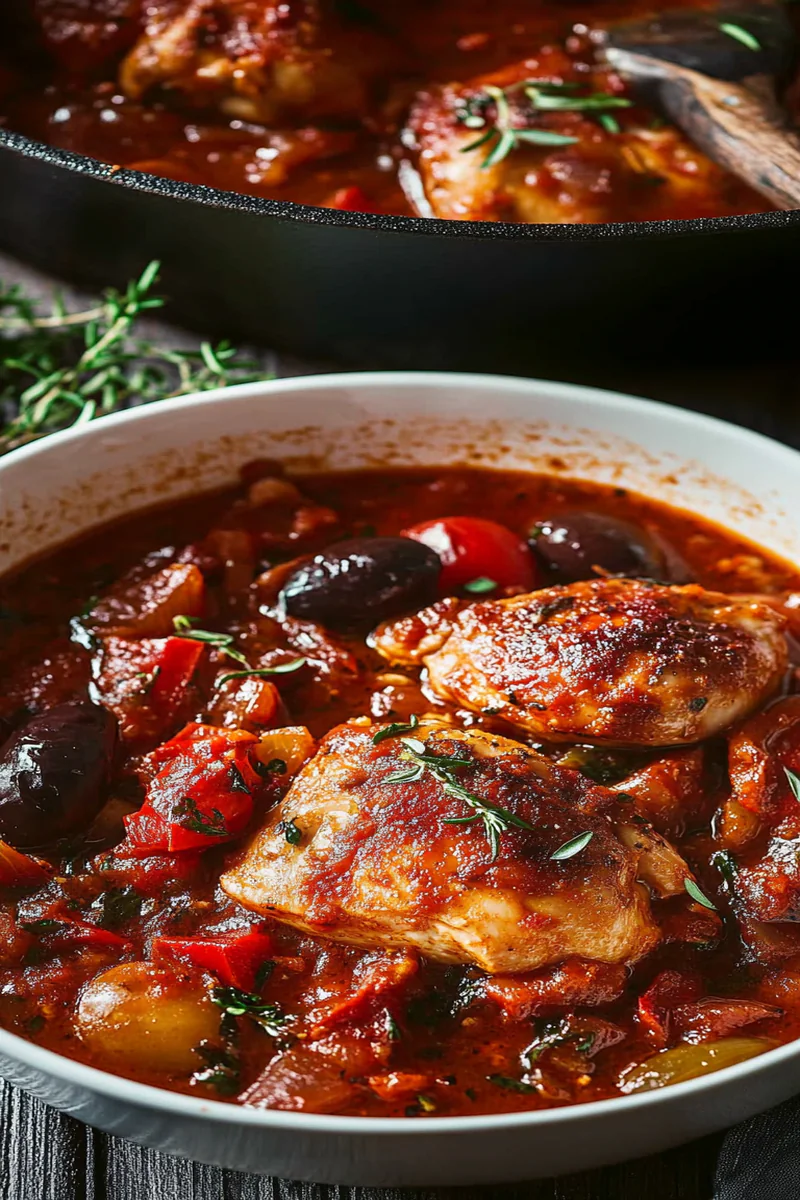
How to Prepare Chicken Cacciatore
Step 1: Brown the Chicken
Begin by heating olive oil in a large skillet over medium-high heat. Once hot, season your chicken pieces generously with salt and pepper before placing them skin-side down into the pan in batches if necessary; avoid overcrowding as this prevents proper browning. Cook each side for approximately 5–7 minutes until golden brown before flipping them over carefully using tongs or spatula so juices remain intact inside each piece.
Once browned on both sides remove from heat onto a plate lined with paper towels while repeating until all pieces are cooked; set aside temporarily while keeping warm under foil if needed later on during assembly stages.
Step 2: Sauté Vegetables
In the same skillet where you browned your chicken (don’t clean it!), add chopped onions first followed by minced garlic after two minutes once onions start turning translucent—this prevents burning! Stir frequently allowing flavors to meld together effectively over medium heat until fragrant (about another 2 minutes).
Next introduce sliced bell peppers along with mushrooms into mix stirring occasionally until softened (around 5–6 minutes); aim for vibrant colors throughout mixture without losing shape completely just yet since they’ll continue cooking alongside remaining ingredients later on!
Step 3: Build Your Sauce
With vegetables softened nicely now is time adding canned diced tomatoes along with tomato sauce stirring well combined throughout casserole-like mixture formed thus far! Pour in low-sodium broth next ensuring everything is submerged evenly before sprinkling dried oregano plus basil over top followed by adjusting seasoning preferences like additional salt/pepper according taste buds’ delightfulness!
Return browned pieces back into skillet nestling them gently amongst bubbling goodness so they soak up those wonderful flavors developed earlier; cover tightly using lid reducing heat down low simmer gently anywhere between twenty-thirty minutes allowing all elements come together harmoniously!
Step 4: Final Touches
After simmering patiently check doneness using internal thermometer inserted through thickest parts ensuring reach minimum safe temperature (165°F); if needing more time simply cover again allowing additional ten-minute intervals checking periodically until ready! Once cooked serve immediately garnished fresh parsley optional kicking presentation factor up notch alongside crusty bread perfect mopping up delicious sauce left behind!
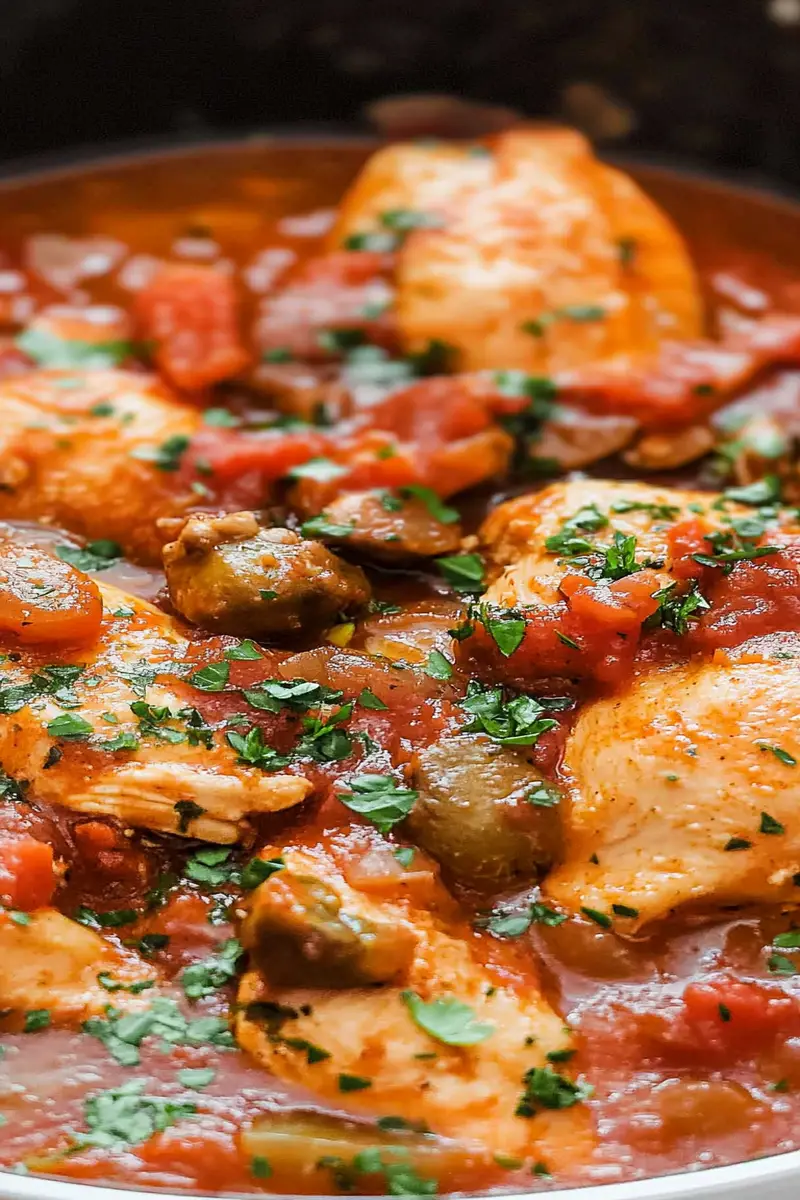
Serving and Storing Tips
Serving Suggestions
When serving your delicious chicken cacciatore consider pairing it alongside creamy polenta or al dente pasta which will complement its rich flavors beautifully! A simple side salad featuring mixed greens tossed lightly vinaigrette dressing provides refreshing balance against hearty nature ensuring complete satisfying meal experience overall! Don’t forget crusty bread either; it’s ideal for scooping up every last bit oozing from bowl leaving no waste behind!
Also consider using colorful serving dishes showcasing vibrancy present within food itself elevating table aesthetics effortlessly while pleasing eyes before palates get involved too much!
Storing Leftovers
If there happens be leftovers after feast time do not fret – storing properly ensures longevity maintaining quality preserved even after days pass! Allow entire batch cool down completely prior transferring into airtight container refrigerated maximum five days safely under usual conditions observed here providing ample opportunity enjoy second servings later without compromising tastes developed earlier cooked lovingly!
For freezing purposes ensure cooled contents placed securely inside freezer-safe containers allowing some space top accommodate expansion once frozen solidly making sure label date clearly visible helps avoid confusion later down line too easy forgotten items found hiding back there somewhere lost depths cold realms chilly spaces waiting rediscovered someday soon hopefully sooner rather than later!
By following these simple steps regarding both serving suggestions plus storage techniques you’ll find satisfaction within every bite enjoyed whether fresh off stove hot served platter round table family gathered sharing laughter conversation bonding memories forged food prepared right hands skilled heart invested wholly truly into crafting masterpiece worthy admiration respect alike among all who partake moment shared together sustenance nourishes body soul alike comforting reminder love comes many forms sometimes simplest ones matter most truly remarkable ways all around us everyday lives lived fully cherished moments created shared forever lasting impressions made hearts minds intertwined forever woven fabric life journey taken together one bite time!
Mistakes to avoid
When preparing chicken cacciatore, avoiding common mistakes can significantly enhance the dish’s flavor and presentation. One frequent error is using low-quality chicken. Opt for fresh, organic chicken thighs or drumsticks. These cuts offer more flavor and moisture compared to breast meat. Cooking with inferior poultry can lead to a lackluster dish that fails to impress.
Another mistake is neglecting to properly season your ingredients. Before cooking, season chicken pieces with salt and pepper. This step enhances the overall taste and allows the flavors to penetrate the meat during cooking. Additionally, be cautious about overcrowding the pan when browning the chicken. If you add too many pieces at once, they will steam instead of sear, resulting in a less appetizing texture.
Failing to balance the sauce is also a common pitfall. A well-made cacciatore sauce should have a harmony of flavors from tomatoes, herbs, onions, and bell peppers. Avoid skimping on these ingredients; they are vital for achieving the right depth of flavor. Overcooking vegetables can lead to mushiness, so be mindful of their cooking time.
Lastly, don’t forget about resting your dish after cooking. Allowing chicken cacciatore to sit for a few minutes before serving lets the flavors meld together beautifully. Skipping this step often results in a dish that tastes good but lacks complexity.
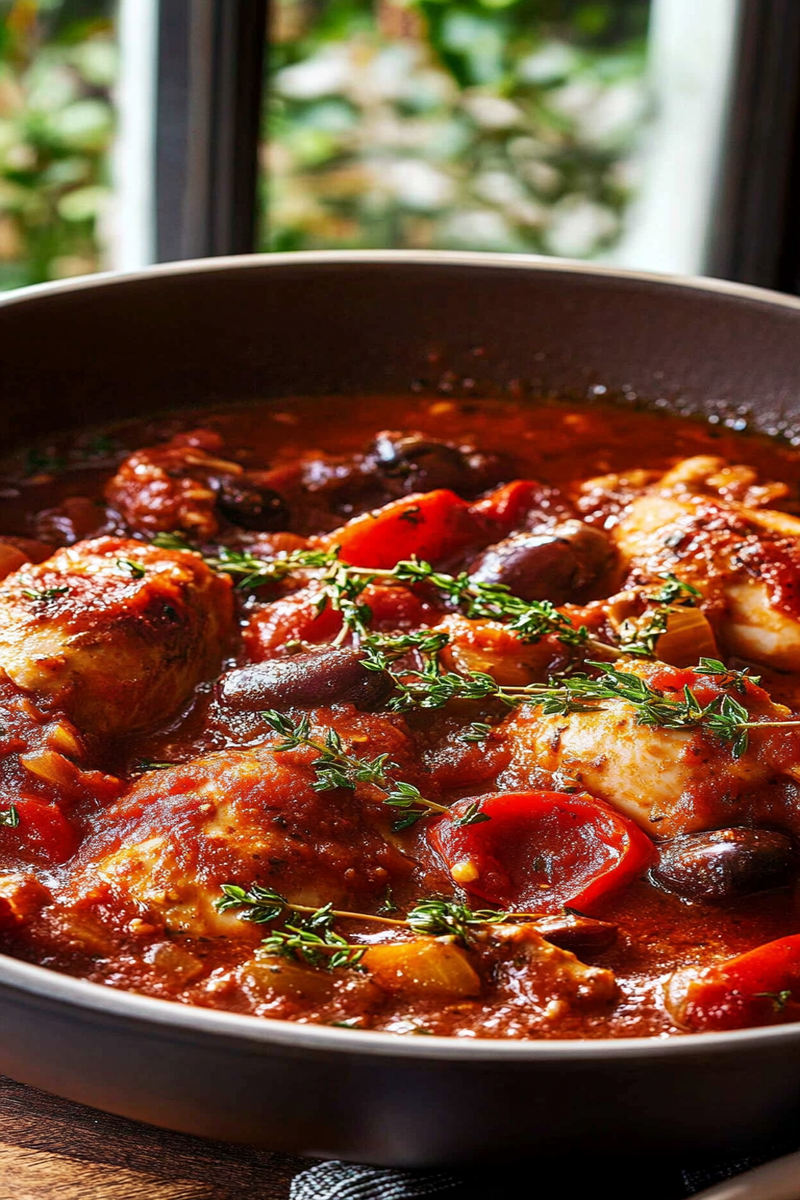
Tips and tricks
To master chicken cacciatore, consider several useful tips and tricks that can elevate your cooking experience. First, marinate your chicken beforehand using olive oil, garlic, and herbs such as rosemary or thyme. This will infuse additional flavor into the meat and make it tenderer when cooked.
Next, use high-quality canned tomatoes for the sauce base. San Marzano tomatoes are renowned for their sweetness and rich flavor profile. They can significantly improve your sauce compared to regular canned varieties. When adding tomatoes, remember to crush them by hand or use a blender for a smoother consistency.
Incorporating fresh herbs during the last few minutes of cooking adds vibrancy to your dish. Fresh basil or parsley sprinkled on top just before serving will not only enhance the appearance but also contribute fresh notes that balance out the richness of the sauce.
Consider serving your chicken cacciatore with complementary sides like crusty bread or creamy polenta. These sides help soak up the delicious sauce while offering contrasting textures to your meal.
Finally, taste as you go! Regularly sampling your dish while cooking allows you to adjust seasonings as needed. A little extra salt or a dash of vinegar can make all the difference in achieving that perfect flavor balance.
Suggestions for Chicken cacciatore
When preparing chicken cacciatore, there are several suggestions that can help refine your approach and yield better results. One key suggestion is to choose between different types of peppers based on personal preferences or seasonal availability. Bell peppers add sweetness while hot peppers introduce heat; combining them may create a delightful contrast in flavor profiles.
It’s also beneficial to think about cooking methods when making this dish. Braising is an excellent technique for developing rich flavors over time; however, you can also opt for a slow cooker if you prefer convenience without sacrificing taste. The slow-cooked version allows flavors to meld beautifully while freeing up time for other tasks.
Adjusting cook times according to your stovetop type is important as well; electric stoves may take longer than gas ones due to heat distribution differences. Keep an eye on your ingredients’ texture during cooking rather than strictly adhering to timing guidelines listed in recipes.
Additionally, consider adding olives or capers towards the end of cooking for an unexpected salty punch that enhances complexity without overpowering existing flavors in your sauce.
Lastly, presentation matters! Serving chicken cacciatore in colorful bowls garnished with fresh herbs creates an inviting display sure to impress guests at any gathering.
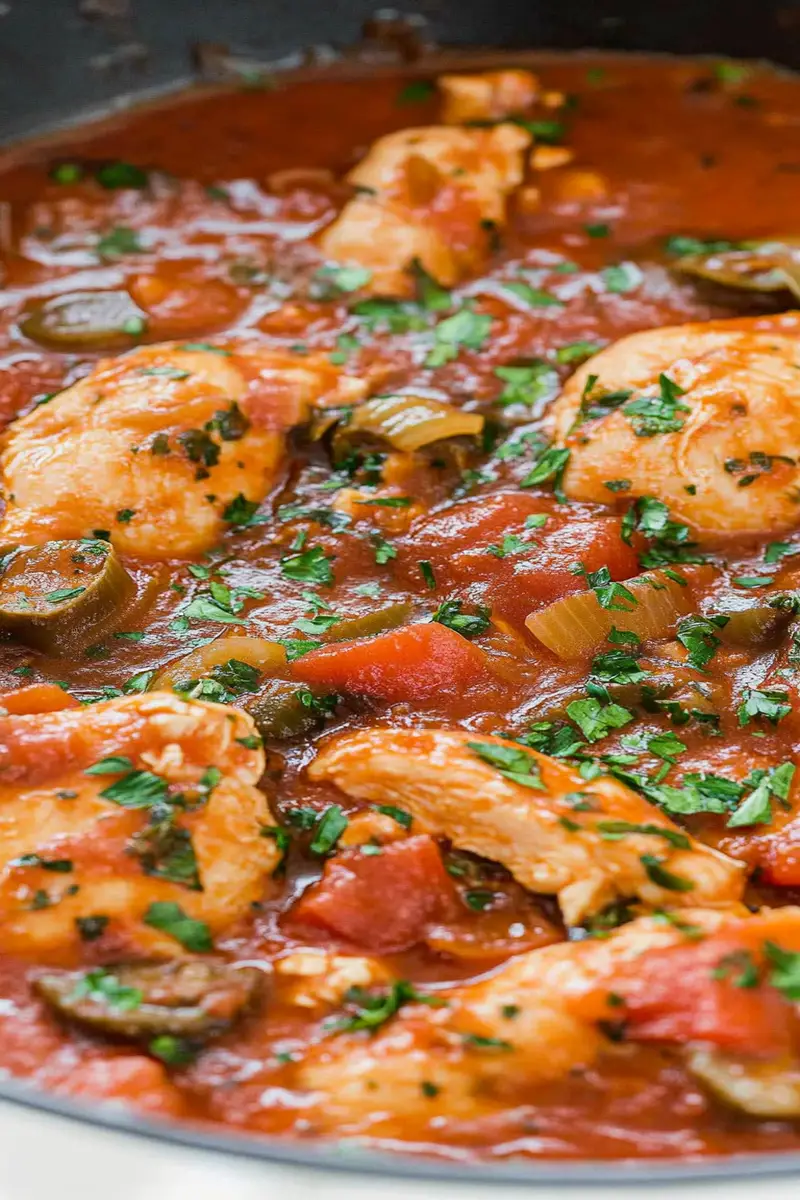
FAQs
What is Chicken Cacciatore?
Chicken cacciatore is a traditional Italian dish known for its rich tomato-based sauce featuring tender chicken pieces cooked until juicy and flavorful. The name “cacciatore” translates to “hunter” in Italian, reflecting how hunters would prepare this hearty meal using available ingredients like tomatoes, onions, bell peppers, and herbs found in their surroundings.
Can I use chicken breast instead of thighs?
While you can use chicken breasts in place of thighs for chicken cacciatore, it’s important to note that breasts are leaner and may dry out more quickly during cooking. Thighs provide more moisture and richer flavor due to their higher fat content; therefore, they are typically recommended for optimal results in this recipe.
What kind of wine should I use?
A dry red wine like Chianti or Merlot works best when making chicken cacciatore as it complements tomato-based sauces well without overwhelming them with sweetness. Choose one that you enjoy drinking; this ensures balanced flavors throughout your dish while enhancing overall taste quality.
How long does it take to cook Chicken Cacciatore?
Cooking time varies depending on factors such as stove type and desired doneness level; however, expect around 45 minutes total once all ingredients are prepared properly—from browning the chicken until simmering everything together until done through thickened sauce consistency achieved ready serve!
Can I freeze leftover Chicken Cacciatore?
Yes! Freezing leftover chicken cacciatore is an excellent way to preserve its flavors for future meals! Store it in airtight containers once cooled completely; label them with date information before placing them into freezer compartments where they’ll remain good quality up six months later!
What should I serve with Chicken Cacciatore?
Chicken cacciatore pairs wonderfully with various sides such as creamy polenta or pasta noodles tossed lightly with olive oil or parmesan cheese—these options soak up tasty sauces beautifully! Crusty bread also makes excellent accompaniment allowing diners savor every last drop from their plates!
Conclusion
In summary, mastering chicken cacciatore involves being mindful of common mistakes while implementing useful tips during preparation processes leading ultimately towards delicious outcomes! Key points include selecting high-quality ingredients like fresh chickens without overcrowding pans when browning them plus balancing robust sauces ensuring harmonious flavors throughout dishes served warm alongside suitable side options enhancing overall dining experiences! By integrating these strategies into cooking routines regularly provides rewarding culinary adventures enjoyed by all who partake—making every meal memorable!
Print
Delicious Chicken Cacciatore Recipe
- Total Time: 55 minutes
- Yield: 4 servings 1x
Description
Chicken Cacciatore is a classic Italian dish featuring tender chicken simmered in a rich, flavorful tomato sauce with vegetables, herbs, and a splash of wine. It’s a comforting, hearty meal that’s perfect for family dinners.
Ingredients
- 4 bone-in, skinless chicken thighs
- 1 tbsp olive oil
- 1 onion, chopped
- 1 bell pepper, sliced
- 2 garlic cloves, minced
- 1 cup dry red wine
- 1 can (14.5 oz) diced tomatoes
- 1 tbsp tomato paste
- 1 tsp dried oregano
- 1 tsp dried basil
- ½ tsp red pepper flakes (optional)
- Salt and pepper, to taste
- Fresh parsley, chopped (for garnish)
Instructions
- Heat olive oil in a large skillet or Dutch oven over medium-high heat. Season the chicken thighs with salt and pepper, then brown them on both sides, about 5-7 minutes. Remove chicken and set aside.
- In the same skillet, add the onion, bell pepper, and garlic. Sauté until softened, about 4 minutes.
- Add the red wine, scraping up any browned bits from the bottom of the pan. Let it cook for 2 minutes.
- Stir in the diced tomatoes, tomato paste, oregano, basil, and red pepper flakes. Return the chicken to the skillet, nestling it into the sauce.
- Cover and simmer on low heat for 30-40 minutes, until the chicken is fully cooked and tender.
- Garnish with fresh parsley before serving.
Notes
- Serve with pasta, rice, or crusty bread to soak up the sauce.
- You can use bone-in chicken breasts instead of thighs if preferred.
- Prep Time: 10 minutes
- Cook Time: 45 minutes

